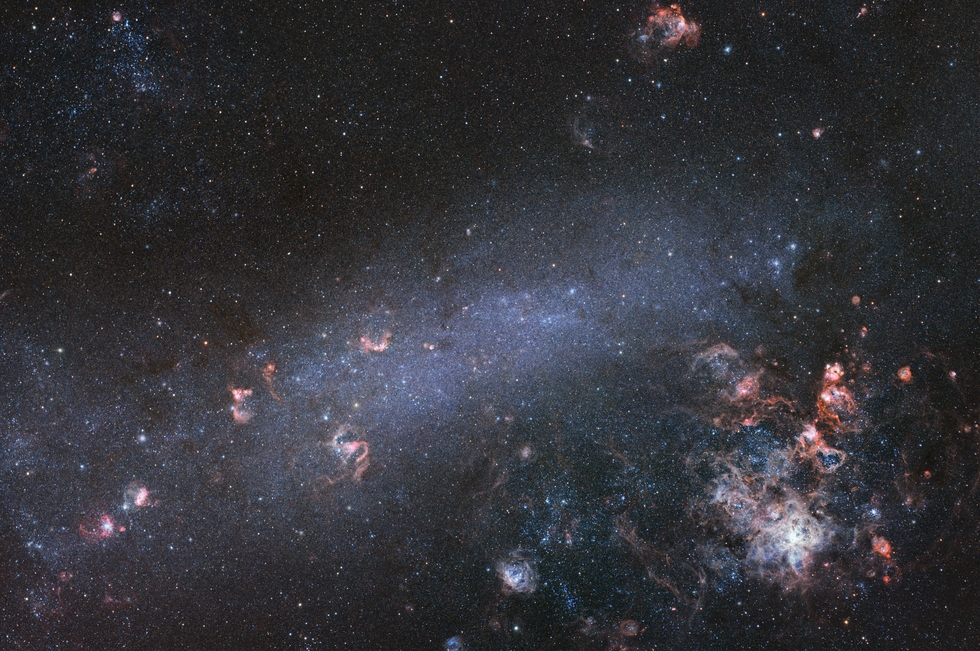Large Magellanic Cloud
Large Magellanic Cloud
Telescope Live is still building this dataset and I was able to add another two hours of observation data. That changed the processing results and the final image considerably - for the better. The dataset is still got a ways to go to get to the 15-20 minimum frame count per filter necessary to enable all the tool functionality in PixInsight. However, just this one additional set of data made a big difference.
I was now able to get a useable starless frame set to go with the Stars frame set. That allowed me to be work in greater detail/more agressively on the Starless data since the Stars were no longer being impacted. I feel it still needs some Oiii/Sii data to full represent the Tarantula Nebual and Cats Paw Nebula components of the LMC. I don't know if Telescope Live has any plans to get additonal narroband data from this OTA on this target, but it would be great if they did. IMO.
Wikipedia:
The Large Magellanic Cloud (LMC), or Nubecula Major, is a satellite galaxy of the Milky Way. At a distance of around 50 kiloparsecs (≈160,000 light-years), the LMC is the second- or third-closest galaxy to the Milky Way, after the Sagittarius Dwarf Spheroidal (~16 kpc) and the possible dwarf irregular galaxy known as the Canis Major Overdensity.
Based on the D25 isophote at the B-band (445 nm wavelength of light), the Large Magellanic Cloud is approximately 9.86 kiloparsecs (32,200 light-years) across. It is roughly a hundredth as massive as the Milky Way and is the fourth-largest galaxy in the Local Group, after the Andromeda Galaxy (M31), the Milky Way and the Triangulum Galaxy (M33).
The LMC is classified as a Magellanic spiral It contains a stellar bar that is geometrically off center, suggesting that it was a barred dwarf spiral galaxy before its spiral arms were disrupted, likely by tidal interactions from the Small Magellanic Cloud (SMC) and the Milky Way's gravity.
With a declination of about −70°, the LMC is visible as a faint "cloud" from the southern hemisphere of the Earth and from as far north as 20° N. It straddles the constellations Dorado and Mensa and has an apparent length of about 10° to the naked eye, 20 times the Moon's diameter, from dark sites away from light pollution.
The Milky Way and the LMC are predicted to merge in approximately 2.4 billion years
I was now able to get a useable starless frame set to go with the Stars frame set. That allowed me to be work in greater detail/more agressively on the Starless data since the Stars were no longer being impacted. I feel it still needs some Oiii/Sii data to full represent the Tarantula Nebual and Cats Paw Nebula components of the LMC. I don't know if Telescope Live has any plans to get additonal narroband data from this OTA on this target, but it would be great if they did. IMO.
Wikipedia:
The Large Magellanic Cloud (LMC), or Nubecula Major, is a satellite galaxy of the Milky Way. At a distance of around 50 kiloparsecs (≈160,000 light-years), the LMC is the second- or third-closest galaxy to the Milky Way, after the Sagittarius Dwarf Spheroidal (~16 kpc) and the possible dwarf irregular galaxy known as the Canis Major Overdensity.
Based on the D25 isophote at the B-band (445 nm wavelength of light), the Large Magellanic Cloud is approximately 9.86 kiloparsecs (32,200 light-years) across. It is roughly a hundredth as massive as the Milky Way and is the fourth-largest galaxy in the Local Group, after the Andromeda Galaxy (M31), the Milky Way and the Triangulum Galaxy (M33).
The LMC is classified as a Magellanic spiral It contains a stellar bar that is geometrically off center, suggesting that it was a barred dwarf spiral galaxy before its spiral arms were disrupted, likely by tidal interactions from the Small Magellanic Cloud (SMC) and the Milky Way's gravity.
With a declination of about −70°, the LMC is visible as a faint "cloud" from the southern hemisphere of the Earth and from as far north as 20° N. It straddles the constellations Dorado and Mensa and has an apparent length of about 10° to the naked eye, 20 times the Moon's diameter, from dark sites away from light pollution.
The Milky Way and the LMC are predicted to merge in approximately 2.4 billion years
SPECIFICATIONS
Telescope
Takahashi FSQ 106ED w/.73 FF/FR (AUS2-CMOS)
Camera
QHY600M
Location
Heavens Gate Observatory, Australia
Date of observation
03/17/2023
Filters
Astrondon LRGB and 3nm Ha
Processing
PixInsight
Credits
Telescope Live


